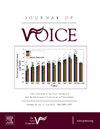Interoception, Voice Symptom Reporting, and Voice Disorders
IF 2.4
4区 医学
Q1 AUDIOLOGY & SPEECH-LANGUAGE PATHOLOGY
引用次数: 0
Abstract
Objectives
Interoception may play a role in how individuals perceive their voice disorder. The first objective of this study was to investigate relationships between interoception and voice disorder class (functional, structural, neurological). The second objective was to determine relationships between interoception and voice-related outcome measures between patients with functional voice and upper airway disorders and typical voice users. The third objective was to determine whether patients with primary muscle tension dysphonia (a type of functional voice disorder) had different levels of interoceptive awareness than typical voice users.
Study Design
Prospective cohort study.
Methods
One hundred subjects with voice disorders completed the multidimensional assessment of interoceptive awareness-2 (MAIA-2). Voice diagnosis and singing experience were also acquired from each patient's medical chart. Voice handicap (VHI-10) and Part 1 of the vocal fatigue index (VFI-Part1) scores were obtained from patients diagnosed with functional voice and upper airway disorders. MAIA-2, VHI-10, VFI-Part1, and singing experience were also obtained from 25 typical voice users. Multivariable linear regression models were used to assess the association between response variables and voice disorder class, adjusting for singing experience, gender, and age.
Results
There were no significant group differences between voice disorder class (functional, structural, neurological) after adjusting for multiple comparisons. Participants with functional voice and upper airway disorders who scored significantly higher on the VHI-10 and VFI-Part1 had lower Attention Regulation sub-scores on the MAIA-2 (P's<0.05). Patients with primary muscle tension dysphonia scored significantly lower on the Emotional Awareness MAIA-2 subscale than typical voice users (P=0.005).
Conclusion
Patients with functional voice disorders with lower capabilities to attend to body sensations may score higher on voice-related patient-reported outcome measures, like the VHI-10 and VFI-Part1. Patients with primary muscle tension dysphonia may also have lower capabilities in processing their body sensations than typical voice users.
感觉、声音症状报告和声音障碍。
目的:感觉可能在个体如何感知他们的声音障碍中发挥作用。本研究的第一个目的是研究互感和语音障碍类别(功能、结构、神经)之间的关系。第二个目的是确定功能性语音和上呼吸道疾病患者与典型语音使用者之间的相互感觉和语音相关结果测量之间的关系。第三个目的是确定原发性肌张力性发音困难(一种功能性语音障碍)患者的内感受意识水平是否与典型的语音使用者不同。研究设计:前瞻性队列研究。方法:对100例嗓音障碍患者进行多维度的内感受觉醒-2(MAIA-2)评定。语音诊断和唱歌经验也从每个患者的病历中获得。声音障碍(VHI-10)和声音疲劳指数第一部分(VFI-Part1)评分是从被诊断为功能性声音和上呼吸道疾病的患者中获得的。MAIA-2、VHI-10、VFI-Part1和歌唱体验也从25个典型的语音用户中获得。多变量线性回归模型用于评估反应变量与嗓音障碍类别之间的相关性,并根据歌唱经验、性别和年龄进行调整。结果:经过多次比较调整后,语音障碍类别(功能、结构、神经)之间没有显著的组间差异。在VHI-10和VFI-Part1中得分显著较高的功能性语音和上呼吸道疾病参与者在MAIA-2中的注意力调节子得分较低(P’s结论:功能性语音障碍患者对身体感觉的处理能力较低,在与语音相关的患者报告的结果测量中得分可能较高,如VHI-10或VFI-Part 1。原发性肌肉紧张性发音障碍患者在处理身体感觉方面的能力也可能低于典型的语音用户。
本文章由计算机程序翻译,如有差异,请以英文原文为准。
求助全文
约1分钟内获得全文
求助全文
来源期刊

Journal of Voice
医学-耳鼻喉科学
CiteScore
4.00
自引率
13.60%
发文量
395
审稿时长
59 days
期刊介绍:
The Journal of Voice is widely regarded as the world''s premiere journal for voice medicine and research. This peer-reviewed publication is listed in Index Medicus and is indexed by the Institute for Scientific Information. The journal contains articles written by experts throughout the world on all topics in voice sciences, voice medicine and surgery, and speech-language pathologists'' management of voice-related problems. The journal includes clinical articles, clinical research, and laboratory research. Members of the Foundation receive the journal as a benefit of membership.
 求助内容:
求助内容: 应助结果提醒方式:
应助结果提醒方式:


